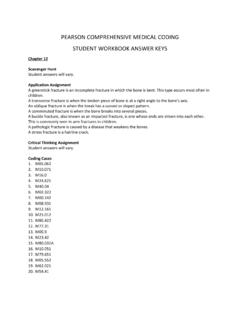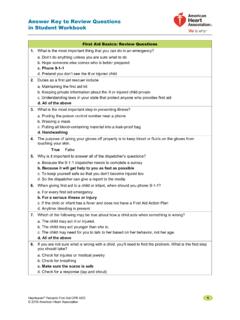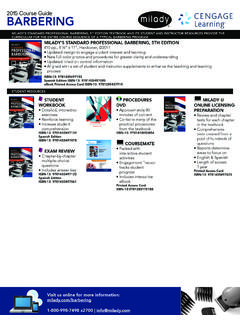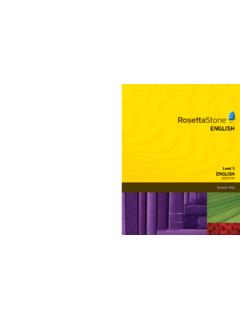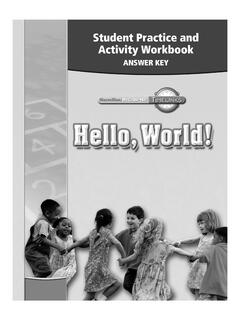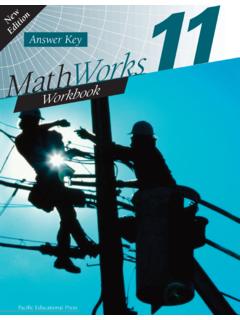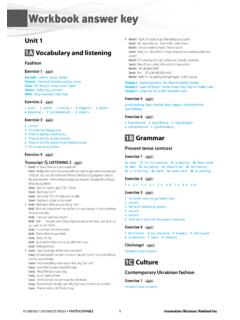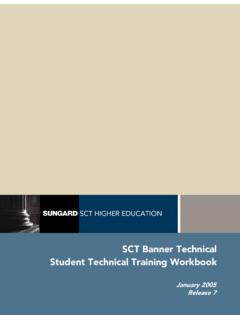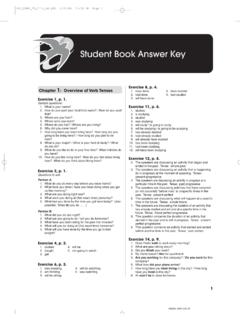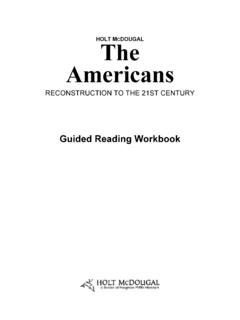Transcription of LATIN FOR THE NEW MILLENNIUM - Bolchazy
1 1 LATIN FOR THE NEW MILLENNIUMS eries InformationLEVEL ONES tudent Text (2 0 0 8) student workbook (2 0 0 8)Te a c h e r s M a n u a l (2 0 0 8)Teacher s Manual for student workbook (2 0 0 8)ANCILLARIESFrom Romulus to Romulus Augustulus:Roman History for the New MILLENNIUM (2 0 0 8)Th e Original Dysfunctional Family:Basic Classical Mythology for the New MILLENNIUM (2 0 0 8)LEVEL TWOS tudent Text (2 0 0 9) student workbook (2 0 0 9)Te a c h e r s M a n u a l (2 0 0 9)Teacher s Manual for student workbook (2 0 0 9)ANCILLARIESFrom Rome to Reformation:Early European History for the New MILLENNIUM (2 0 0 9)Th e Clay-footed SuperHeroes:Mythology Tales for the New MILLENNIUM (2 0 0 9) ELECTRONIC RESOURCES(See pages 443 and 446 for detailed description) Question BankLatin-only Villa in Second Life Carpe Praedam1 Bolchazy -Carducci Publishers, , Illinois USAM ilena Minkova and Terence TunbergSeries Editor: LeaAnn A.
2 OsburnVolume Editors: Elisa C. Denja, LeaAnn A. OsburnContributing Editors: Laurie Haight Keenan, Karen Lee Singh, Donald E. Sprague, Rose WilliamsProofreader: Gary VarneyCover Design & Typography: Adam Phillip VelezCover Illustration: Roman Forum Bettmann/CORBISL atin for the New MillenniumTeacher s Manual, Level 1 Milena Minkova and Terence Tunberg 2008 Bolchazy -Carducci Publishers, rights reservedBolchazy-Carducci Publishers, Baskin RoadMundelein, Illinois in the United States of America2009by United GraphicsISBN 978-0-86516-562-5 CONTENTSLIST OF ABBREVIATIONS .. tm viPREFACE .. tm viiRESOURCE LIST .. tm ixSTUDENT TEXTBOOK .. iwith Exercise Answers, Standards Correlations, Oral Exercises, Oral Exercise Correlations, workbook Exercise Correlations, Ancillary Correlations, Comprehension Questions and Answers, Teaching Tips, Teacher By the Way Notations, and How to Use Th is Book TM v LIST OF ABBREVIATIONSCPOC lassroom Presentation Options ( , black/green/white/smart board, overhead or LCD projector, PowerPoint presentation, etc.)
3 ODFO riginal Dysfunctional Family (classical mythology ancillary)RRAFrom Romulus to Romulus Augustulus (Roman history ancillary) TM vi PREFACE TM vii LATIN for the New MILLENNIUM is designed as a comprehensive introduction not only to the LATIN language and how it works but also to the Roman world, the cultural milieu in which the language fl ourished. Th e language and cultural elements are seamlessly woven together in the course of each chapter and then again examined in the review following every three AND COURSE COMPONENTSMETHODOLOGICAL APPROACHIn writing LATIN for the New MILLENNIUM , we have aimed at combining the best elements in the various method-ologies for teaching LATIN that have been commonly available until now.
4 Modern methods of teaching LATIN have been divided between two approaches: (1) the analytical or deductive method according to which stu-dents must learn rules and paradigms, and then reinforce the knowledge of these abstract principles by practice with texts and exercises; (2) the inductive or reading method that enables the student to read a text and to become aware of linguistic features (or rules) from the reading and study of the text. In LATIN for the New Mil-lennium we hope to have combined the advantages of each. In other words, we have striven to provide a path to a thorough and systematic knowledge of the structure of the language, the main advantage of the analytical method, together with a great deal of reading and activities related to reading that lead to a more intuitive grasp of the idiomatic qualities of the language, the main advantage of the reading method.
5 Th e layout of each chapter is the key to this combination, since the student begins each chapter with an ex-tensive reading, and these initial passages contain, in a context understandable through induction and annota-tions, instances of every new element to be explored further in the same chapter. In the body of each chapter, aft er the introductory reading, these new elements are explained in a more analytic way, yet the explanations always refer the learner back to the reading in ways that invite comparison with the initial READINGSTh e principal readings in each chapter consist of passages adapted (to the level of knowledge presupposed for each chapter) from some of the most signifi cant works of LATIN literature. Th e introductions to each passage give considerable information about the cultural context in which each author wrote, and about the develop-ment of the LATIN literary tradition.
6 Th e order of the chapter readings is chronological. In Level 1, students begin with readings from Plautus and Terence and proceed through the centuries to the writings of Ammi-anus, Augustine, and Boethius. By completing the entire course contained in LATIN for the New MILLENNIUM , students will gain an understanding of the entire patrimony of LATIN and its eff ect on our culture. W hile Level 1 of LATIN for the New MILLENNIUM focuses on the classic texts in LATIN writt en by such great Roman authors as Vergil, Catullus, Cicero, and Ovid, Level 2 of the series centers on the huge and fundamental heritage of works writt en in LATIN during the medieval, renaissance, and early modern periods a linguistic heritage that gave us our basic vocabulary in the national languages for telling time, medicine, the natural sciences, and the academic world.
7 Th e cultural information that is found in these readings and their introductions are bolstered in both levels by the Review Exercises and supplementary material pertaining to mythology, Roman history, and important LATIN sayings. ORAL LATIN AND LATIN CONVERSATION A person who gains an active facility in any language, in addition to a reading ability, is, in our view, more likely to progress quickly to a deep understanding of the language and the works writt en in it. Our experience indicates that a student who learns by using a language will probably not need to be reminded about forms and grammatical rules as oft en as a learner who lacks active practice. Th erefore, in every chapter of LATIN for the New MILLENNIUM , we have included a set of exercises that concentrate on an oral exchange between instructor and students .
8 Th e oral exercises in LATIN for the New MILLENNIUM can be completed without any extempore speak-ing ability on the part of the teacher. Th is is possible because the oral exercises are found only in the teacher s manual. Here not only are all the answers supplied, but every question is writt en out in full for the teacher, along with detailed instructions for each step of the exercise. Th e teacher needs only to follow the instructions and read each question aloud. Th e response must come from the learner. GRAMMARG rammar is also a great help for acquiring a sophisticated understanding of any language, and especially a lan-guage like LATIN , which is primarily studied today by people whose main goal is to read works of literature writ-ten in the original LATIN language, works which were designed from the start for a cultivated audience.
9 W hile we believe in the value of the reading method, and we know how active usage of a language can vastly improve and accelerate a student s learning of that language, we also recognize the utility of grammar. Th erefore, while each chapter is rich in exercises and activities, we have taken care to provide explanations of all the grammar relevant to each chapter. Th e student who uses LATIN for the New MILLENNIUM learns by actively using LATIN , but is also asked to understand the structure of the language and apply that understanding in the CHAPTER ELEMENTS Memor bile Dict Each chapter features a famous saying, labeled Memor bile Dict , a LATIN phrase that is so well known that it has became a proverb in many languages. Learning each famous saying will in-crease a student s understanding not just of LATIN , but also of English.
10 Th ese sayings invite discussion of their meaning and how they relate to the modern world and students experiences. Reading Vocabulary A ll the new vocabulary in the reading passage at the beginning of each chapter is explained by copious notes. students need not be required to learn the vocabulary that faces the reading passage. A unique feature of the Reading Vocabulary is that not all the verbs show in print their pronoun subject. For example, if the sentence in the reading might be Cicero Terentiam videt, videt in the Read-ing Vocabulary would have as its defi nition sees rather than he sees. Th is has been done to avoid the common beginner s mistake of translating the sentence as Cicero he sees Terentia. On the other hand, if the sentence were to read Terentiam videt, videt would be defi ned he sees.
